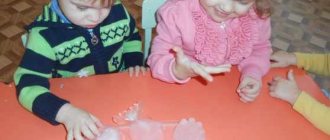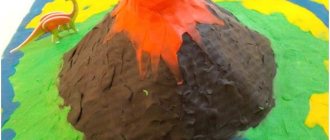Exciting experiments with magnets for children with explanations
We suggest considering experiments with magnets using ingenuity and ingenuity. For example, heat has a destructive effect on magnetic properties.
With a candle
We also propose to refute the theory that only iron is subject to magnetic influence. An exception is, for example, matches.
With matches
Let's improve the theory about the strength of a magnet a little.
Magnetic gun
We suggest creating a magnetic mechanism with your own hands.
Experiment
Using a similar algorithm, you can try different shapes of wire.
Rotation under magnetic influence
Or you can make a homemade fan! By the way, if you change the pole that touches the magnet, the direction of movement of the wire will change.
Experiment
Or you can make such an engine with your own hands.
Engine
And finally, create an almost perpetual motion machine from a magnet, a battery and copper wire (if you close the wire in a circle). Until the battery runs out. All these experiments operate on the principle of a simple electric motor - electrons move along a wire, and a force acts on them.
Magnetic train
Don't be afraid to experiment - experiments with magnets are so exciting and varied that they can surprise even adults.
Card index of experiments and games with magnets
Table of contents
PART 1. EXPERIMENTS AND EXPERIMENTS WITH MAGNETS
……………………………………………………………………………………………….. 4
EXPERIMENT 1. WHAT MATERIALS DOES A MAGNET ATTRACT?…………………………………………………………………………………………………………………………………….. 4
EXPERIMENT 2. MAGNETS ACT AT A DISTANCE……………………………………………………………………………………………………………………. .6
EXPERIMENT 3. A MAGNET HAS TWO POLES…………………………………………………………………………………………………………………………………………… ……………… 8
EXPERIMENT 4. HOW TO SEE THE MAGNETIC FIELD? ………….. 9
EXPERIMENT 5. MAGNETIC PROPERTIES CAN BE TRANSFERRED TO ORDINARY IRON……………………………………………………………………………………………… 10
EXPERIMENT 6. MAGNETIC FIELD OF THE EARTH…………………………………………………………………………………………………………………… ……………….. eleven
PART 2. GAMES WITH MAGNETS
……………………………………………………………………………………………………………………………………. 12
MAGNETIC PUPPET THEATER……………………………………………………………………………………………………………………………………………… ……….. 12
VOLUMETRIC LABYRINTH…………………………………………………………………………………………………………………………………………………… ………………………. 15
PICTURE MAZE “CAT AND MOUSE”…………………………………………………………………………………………………………………………………………… ….. 16
PENCIL POINT-MAGNETIC CONSTRUCTOR ON A CAN……………………………………………………………………………………………………………………………………. 18
FUNNY KNOCKS……………………………………………………………………………………………………………………………………… ……………………………. 19
CONCLUSION………………………………………………………………………………………………………………………………… ……………………………………. 21
3
What is a magnet?
This is a body that can attract iron and steel objects. Known for a long time, even the ancient Chinese knew about magnets more than two thousand years ago. Magnit - from the name of the region where magnetic deposits were discovered - Magnisia. This is in Asia Minor.
We have already said that the Earth is a magnet, add also that a magnetic field also exists in a person. Tell us about people who attract iron objects. There are many videos and photographs with examples on the Internet. The magnetic field in a person makes his energy shell visible through special equipment.
If you told your child about the galaxy, then he will find it interesting that the planets in the solar system are also giant magnets.
Tell your child about the types of magnets. There are natural ones - deposits of magnetic ores - and artificial ones - created by man from hard magnetic materials or using electric current.
Lesson summary “Magic stone - magnet” Experimentation Preparatory group
Guys, do you know where the magnet came from?I will be happy to tell you an old legend. Many, many years ago, people found a black mineral stone with a beautiful metallic sheen in the mountains. People noticed that shoes and sandals lined with iron stuck to the black stones. This natural, natural stone was called magnetite. Scientists believe that the name “magnetite” comes from the name of the city near which it was found – Magnesia.
Let's repeat what the natural stone was called, that's right guys - magnetite.
The unusual property of magnetite - to attract iron - is called magnetism. Let's repeat what the property of a stone to attract iron to itself is called - magnetism.
These magnetites quickly lose their magnetism, so a person cannot use them forever. Then people decided to make magnets from these stones that would retain the power of magnetism for a very long time, and they called them permanent, or artificial. Let's repeat what a magnet that a person creates himself is called, that's right guys - permanent or artificial.
Before we start conducting experiments, I want to remind you that you need to follow the rules of conduct. Let's remember together how to behave.
Listen carefully to the teacher.
Don't talk too loudly so as not to disturb each other.
Do not touch without permission, do not put in mouth, be careful.
Do not forget to draw a conclusion after each experiment. And we will indicate these conclusions using diagrams.
I suggest we take a closer look at this amazing stone. Let's come to the table.
What does a magnet feel like? Is the magnet light or heavy?
Let's give a definition - “A magnet is a stone, its surface is cold, smooth, has weight.....”.
Well done boys.
Let's do the first experiment.
Experiment No. 1. “What materials does a magnet attract?”
Do you think all objects are attracted by a magnet? Who believes that a magnet can attract everything to itself?
To test your assumptions, I invite everyone to come to the table. Look what objects are on the table?
I suggest you choose those objects that, in your opinion, a magnet can attract to itself.”
How to check if you made the right choice?
What objects did the magnet attract?
What items didn’t you attract?
What can be concluded?
That's right guys, they are all made of iron. This means that a magnet attracts only iron objects. Objects made from other materials are not attracted. This property of attracting objects to itself is called magnetism, from the word magnet.
Conclusion: A magnet only attracts iron objects.
Let's mark it on our diagrams.
Let's go to the next table and continue the experiments.
Experience No. 2.
“
Do magnets act at a distance?”
Guys, look, there is a line drawn on the paper, next to this line I put a paperclip. Now we will slowly move the magnet towards this line. At some distance from the line, the paperclip will suddenly “jump” and stick to the magnet; this distance must be noted.
Let's do the same experiment with other magnets. You can see that some of them are strong - they magnetize a paper clip from a farther distance, others are weak - they magnetize a paper clip from a close distance. Moreover, this distance does not directly depend on the size of the magnet itself, but only on its magnetic properties.
Guys, let's draw a conclusion.
Conclusion. There is something around a magnet that can act on objects at a distance. This something was called a “magnetic field”.
Experiment No. 3.
“Is the magnet not afraid of obstacles?”
Guys, we learned that there is a magnetic field. What do you think, if a magnet is so strong and attracts objects at a distance, does its force act through obstacles, through other materials? And who can tell me what a barrier is?
What do we have on the table?
Let us check whether the magnetic force acts through an obstacle?
There are glass mugs in front of you, you put a paper clip in the mug, I will pour water into the mugs. Now think and tell me - how to get a paper clip out of the water without getting your hands wet? How can I do that?
What can be concluded?
Conclusion: Magnetic force, a magnetic field, acts through cardboard, plastic, wood, glass and water.
Let's mark it on the diagram.
And here I have prepared a problem for you. Look carefully at this plate. What do you see in her? (Semolina) I hid something under the semolina, and you must find it, but you can’t touch the plate, you can’t pour the cereal in, or touch it with your hands. Think about how you can find a treasure, what can help you?
Well done right. Retrieve objects hidden in semolina using magnets.
Let's move on to the next table.
Experiment No. 4. “A magnet has two poles.”
How do you think two magnets will behave if they are brought close to each other? Let's check. If you take any two pieces of a magnet and bring them close to each other, it will turn out that they attract at one end and repel at the other. This means that magnets can attract or repel depending on which side you bring them to each other. One end is called the south or positive pole of the magnet and is marked with a “+” sign. The other end is the north, negative pole of the magnet, marked with a “-”. So we learned that a magnet has poles, like poles repel, and different poles attract. Let's repeat, like poles repel, and unlike poles attract.
Look at these toys: if you move the hare figurine towards the bear, the bear begins to run away from the hare. What is this focus based on? Knowing about the properties of the poles of a magnet, it is not difficult to guess that both the figure of the hare and the bear contain magnets located towards each other with the same poles.
Which scheme we will choose, which one will be correct.
What can be concluded?
Conclusion. Magnets are attracted to each other by opposite poles, and repelled by like poles. Like poles repel, and unlike poles attract.
Let's now clarify what properties of a magnet we got acquainted with today? You can tell it according to the diagram.
A magnet only attracts iron objects.
There is something around a magnet that can act on objects at a distance. This something was called a “magnetic field”.
Magnetic force, the magnetic field, operates through cardboard, plastic, wood, glass and water. Magnets operate at a distance.
A magnet has two poles, like poles repel and unlike poles attract.
Guys, what amazing stone did we get to know about the properties of today? That's right, guys with a magnet. And whoever remembers the name of the natural stone that people found in the mountains, that’s right guys - magnetite. And the unusual property of magnetite - to attract iron - is called magnetism. Well done.






